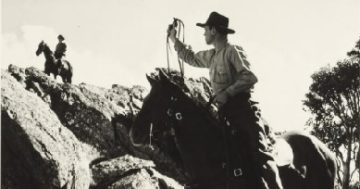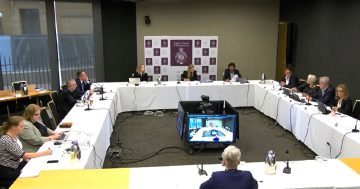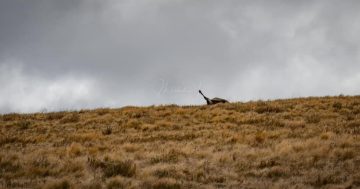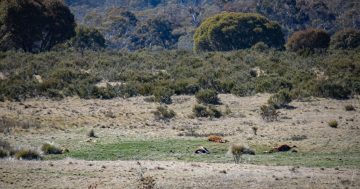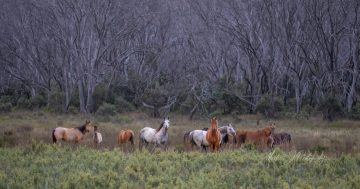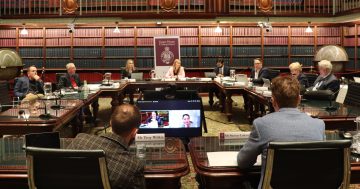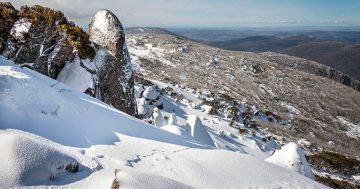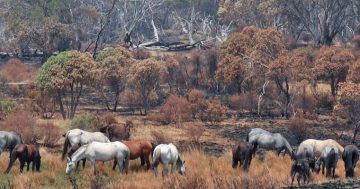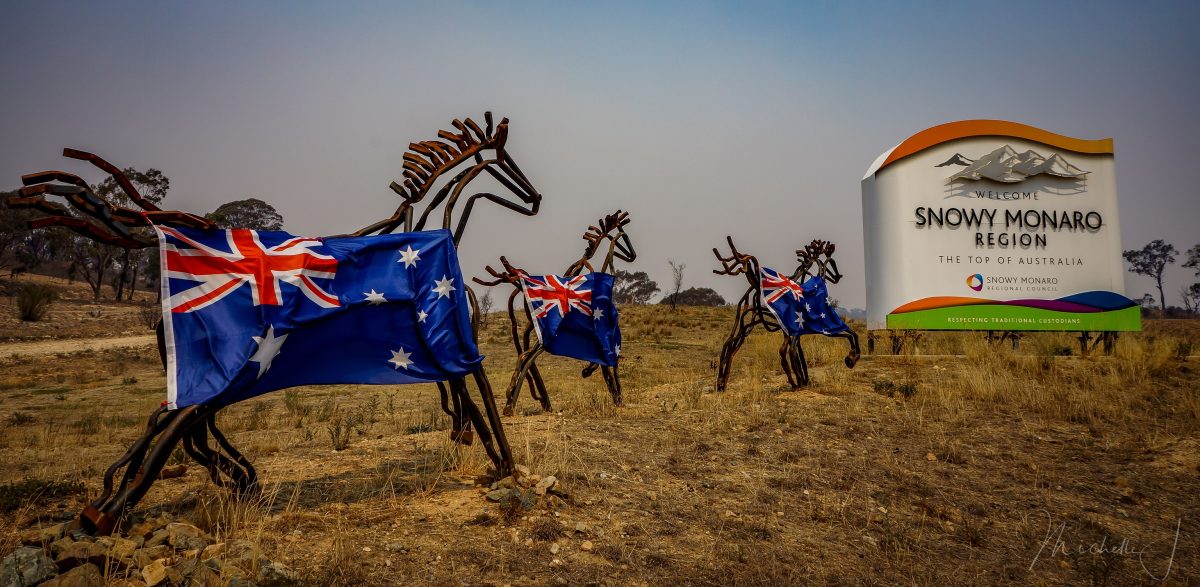
Australia Day was celebrated in fun and fine fashion recently, with visitors to the Snowy Monaro region greeted by flag-bearing wild horses. Photo: Michelle Brown.
Large sections of Kosciuszko National Park (KNP) will be closed for up to seven months this year as the State Government ramps up its program of aerial shooting of wild horses and other feral animals.
Alerts for the southern and northern blocks of the park recently issued by the NSW National Parks and Wildlife Service (NPWS) ahead of the closures indicate the aerial shooting operations will not only target the wild horses, known as brumbies, but shooters will also have their sights trained on deer, pigs and other feral animals.
The southern block, which runs from the Alpine Way down to the NSW-Victoria border – including Byadbo and Pilot Wilderness Areas – will firstly be temporarily closed from 2-28 March.
All tracks, trails, campgrounds, huts, picnic areas and accommodation nodes within the closure areas will be shut during this period, including The Australian Alps Walking Track south of the Alpine Way to Cowombat Flat and Pilot Wilderness mountain bike ride.
All campgrounds and day-use areas along the Barry Way remain open.
Operations in the northern section of the park will then begin in earnest from 7 am on Thursday, 24 April, to 7 pm on Friday, 4 October, targeting the area north of the Snowy Mountains Highway and east of the Goobarragandra Powerline Road, close to the NSW-ACT border.
Again, all tracks, trails, campgrounds, huts, picnic areas and accommodation nodes within the closure areas – which impact 19 locations in the park – will be shut during this period.
Resort precincts are not impacted by the closures. Visitors will still be able to access the alpine resorts, Mt Kosciuszko and Yarrangobilly Caves and sections of the recently completed Snowies Alpine Walk.
Visitors with impacted campground bookings will be notified and full refunds made.
Wild-horse control is occurring in accordance with the Kosciuszko National Park Wild Horse Heritage Management Plan (KNP WHHMP), which came into force in November 2021.
The NPWS maintains there is strong scientific evidence the wild horses damage the park’s fragile alpine and sub-alpine environment by trampling and grazing vegetation, eroding waterways and destroying key habitats for threatened species such as the northern corroboree frog and stocky galaxias fish.
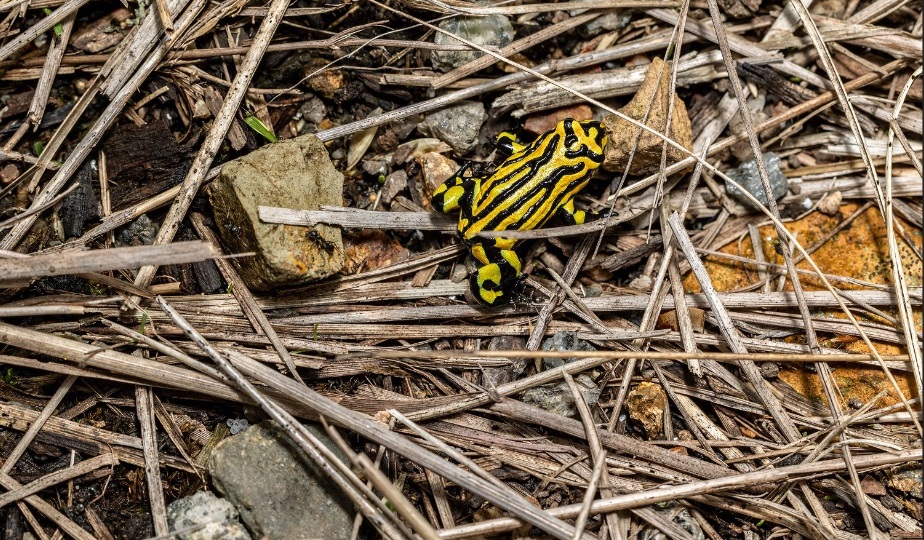
The northern corroboree frog is just one species the Invasive Species Council claims is under threat from wild horses in Kosciuszko National Park. Photo: NSW DPI.
Based on an October 2023 population survey, the NPWS says an estimated 12,934 to 22,536 wild horses, averaged out at 17,393 horses, inhabit the park, meaning that by law they must be reduced to 3000 by June 2027.
The remaining population will be kept in retention management areas because they reflect the alpine region’s wild-horse heritage values.
These include Kiandra greys, McDonald Silver and Taffy horses, Currango and Long Plain roans and bays, Cascade horses, Byadbo and Pilot horses.
But brumby supporters are concerned the aerial cull will decimate heritage mobs that they say are already at risk due to recent culling operations.
There has been speculation the Cascade mob – based on Australian author Elyne Mitchell’s series of Silver Brumby children’s books – has already been wiped out.
But culling operations could not come fast enough for the Invasive Species Council (ISC), which says without an effective control program now, the feral horse population in KNP will continue to grow, meaning more feral horses will need to be culled in the future as environmental damage escalates.
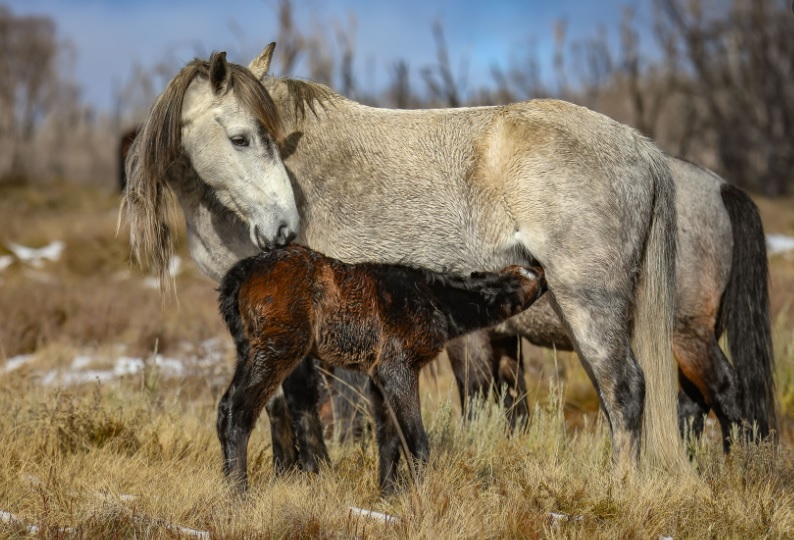
Concerns are mounting among brumby supporters that young foals will be injured or lost as mobs of wild horses are targeted by aerial shooters. Photo: Michelle Brown.
A post-2019-2020 Black Summer bushfire recount, released in January 2021, had put the population at just over 14,000 brumbies across the north and south of the park.
NPWS figures indicate that between November 2021 and December 2023, 3530 wild horses had been removed either by rehoming (866), sent to the knackery (614), ground shooting (1022), yard shooting (109) or destroyed in the yards using a tranquilliser and bolt gun (70).
Other deaths accounted for 14 wild-horse deaths, 33 horses were euthanased and 802 were culled by aerial shooting in the six months to December 2023.
The KNP WHHMP was amended on 23 October, 2023, to authorise aerial shooting as an approved control method in addition to existing control methods such as trapping, rehoming, and ground shooting for horses in KNP.
In November 2023, NPWS conducted a preliminary aerial shooting program of wild horses in KNP where two independent veterinarians observed 270 horses shot over two days.
The independent report from the program found no adverse animal welfare incidents, including no non-fatally wounded animals, with a median time to insensibility of less than five seconds.
RSPCA NSW also independently observed the preliminary program and confirmed it did not observe any departures from the standard operating procedure or any non-compliance with the Prevention of Cruelty to Animals Act 1979.
Back then, the NSW Environment Minister Penny Sharpe said rolling closures of areas of KNP would be necessary as part of staff and visitor safety mitigation.
The closures, she said, would further reduce the aesthetic and recreational impacts of carcasses by permitting time for decomposition to begin.
Closure notices will be placed at relevant access points in KNP and penalties apply for non-compliance.
Brumby supporters and park users disputing the NPWS count methodology and population numbers are still rallying behind efforts to raise funds for an independent high-tech horse population survey at the northern end of the park.
Organiser and spokesperson Rocky Harvey said the support from throughout Australia and overseas had been extraordinary, with the $78,260 raised exceeding the crowdfunding target of $75,000.
He said it was only a matter of time before fixed-wing aircraft would be deployed to undertake the survey.
This week’s park closure alerts also mean wild-horse orphan groups have jumped into action, with supplies being transported to the Snowy Monaro in anticipation of the discovery of lost foals.
Pundits will also be tuning into the 5 February NSW Senate inquiry into the aerial shooting of wild horses as its second hearing gets underway.
Original Article published by Edwina Mason on About Regional.







